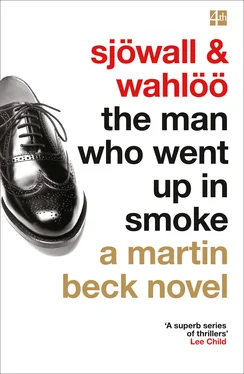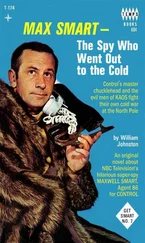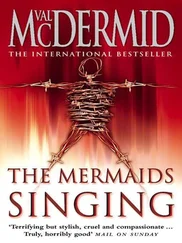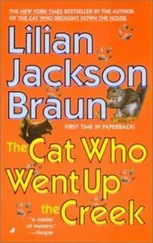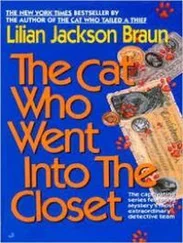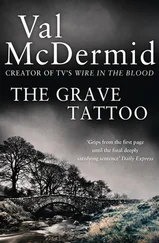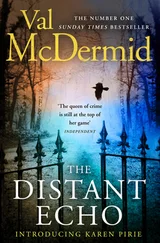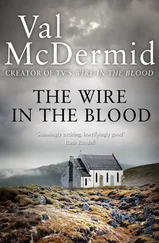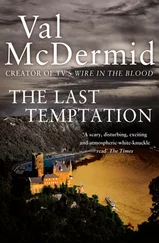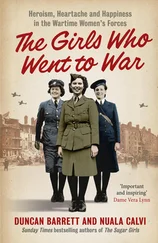But more than this, he is part of a team, each member of which is a fully realized character. His strengths and weaknesses are balanced by those of his colleagues. He relies on them as they rely on him. This is a world where ideas are kicked around, where no individual has the monopoly on shafts of brilliant insight. Nor are the repetitive tedious tasks carried out offstage by minor minions. Both action and routine are shared between Beck and his underlings. Friendships and enmities are equally tested in the course of the ten books, and everyone is portrayed as an individual who has virtues and vices in distinct measure.
Of itself, that would be enough to mark these books out as different from the run of the mill. But Sjöwall and Wahlöö add other elements to the mix which demonstrate the uniqueness of their vision.
Their plots, for example, are second to none, both in terms of structure and subject. Sometimes it's the starting point which is surprising, a seemingly eccentric moment that leads cunningly to the heart of something much darker. Sometimes it's the choice of the underlying issue which confounds us; lulled into thinking we're getting one kind of story, we suddenly find ourselves in a very different place. Wherever their stories take us, Sjöwall and Wahlöö find ways to catch the reader on the back foot, making us reassess our take on the world.
Then there is that aspect that Julian Symonds picked on so astutely – their interest in the philosophical aspects of crime. These days, it is a given that the crime novel is capable of shining a light on society, of illuminating us to ourselves. At its best, the contemporary crime novel tells us how our society works, revealing its social strata and its patterns. It can strip away the surfaces, leaving the malign and the benign exposed, and it can use both characters and storylines to excoriate us for our sins.
But back when Sjöwall and Wahlöö started writing, those jobs were left to literary novelists. Crime writers were supposed only to entertain. The Swedish duo demonstrated that there was a different way to write about murder. Through the eyes of Martin Beck and his colleagues, they held a mirror up to Swedish society at a time when the ideals of the welfare state were beginning to buckle under the realities of everyday life. They write unsparingly and unswervingly about social ills and problems, but they never forget that they are writing novels, not polemics. They dress up their social concerns in fast-moving storytelling, never losing sight of the need to keep their readers engaged.
The end product, though serious in its intent, is far from gloomy. Sjöwall and Wahlöö are blessed with the gift of humour. It manifests itself in the sly, dark wit of Beck, but also in the knockabout farce that erupts from time to time, generally through the characters of Kristiansson and Kvant, a pair of patrol cops who are as stupid as they are unlucky. Their slapstick interludes are as funny to the reader as they are frustrating to the detectives. Before Sjöwall and Wahlöö, such a pair of Keystone Kops would have been unthinkable, undermining as they do the seriousness of police investigation and bringing it squarely into the realm of normal human behaviour.
In many respects, however, The Man Who Went Up in Smoke is an exception to the rest of the novels. It takes place mostly outside Sweden, in Budapest, at a time when the cold war was still an unnerving backdrop to everyday life. For much of the book, Beck is on his own in a strange land, without back-up and without any visceral understanding of the society he's trying to operate in. His investigation into the disappearance of a Swedish journalist seems to run into brick walls at every turn, growing more and more baffling with each successive revelation.
Soon we come to understand that Beck can't crack the case on his own. He has to draw on help both from his colleagues at home and from unexpected sources in Budapest before the pieces can finally fall into place, revealing a truth that manages to be both banal and original.
Sjöwall and Wahlöö won the Mystery Writers of America's Edgar award for Best Novel in 1971 with The Laughing Policeman. It remains the only novel in translation ever to have won the award. To me, that's not particularly surprising. I guarantee if you read their books, you'll end up agreeing with me. And with all the other crime writers who know only too well how much we owe to that pair of Swedish journalists turned novelists.
Val McDermid
The room was small and shabby. There were no curtains and the view outside consisted of a grey fire wall, a few rusty armatures and a faded advertisement for margarine. The centre pane of glass in the left half of the window was gone and had been replaced by a roughly cut piece of cardboard. The wallpaper was floral, but so discoloured by soot and seeping moisture that the pattern was scarcely visible. Here and there it had come away from the crumbling plaster, and in several places there had been attempts to repair it with adhesive strips and wrapping paper.
There were a heating stove, six pieces of furniture and a picture in the room. In front of the stove stood a cardboard box of ashes and a dented aluminium coffee pot. The end of the bed faced the stove and the bedclothes consisted of a thick layer of old newspapers, a ragged quilt and a striped pillow. The picture was of a naked blonde standing beside a marble balustrade, and it was hanging to the right of the stove so that the person lying in the bed could see it before he fell asleep and immediately when he woke up. Someone appeared to have enlarged the woman's nipples and genitals with a pencil.
In the other part of the room, nearest to the window, stood a round table and two wooden chairs, of which one had lost its back. On the table were three empty vermouth bottles, a soft-drink bottle and two coffee cups, among other things. The ash tray had been turned upside down and among the cigarette butts, bottle tops and dead matches lay a few dirty sugar lumps, a small penknife with its blades open, and a piece of sausage. A third coffee cup had fallen to the floor and had broken. Face down on the worn linoleum, between the table and the bed, lay a dead body.
In all probability this was the same person who had improved upon the picture and tried to mend the wallpaper with strips of adhesive and wrapping paper. It was a man and he was lying with his legs close together, his elbows pressed against his ribs and his hands drawn up towards his head, as if in an effort to protect himself. The man was wearing a woollen vest and frayed trousers. On his feet were ragged woollen socks. A large sideboard had been tipped over him, obscuring his head and half the top part of his body. The third wooden chair had been thrown down beside the corpse. Its seat was bloodstained and on the top of the back handprints were clearly visible. The floor was covered with pieces of glass. Some of them had come from the glass doors of the sideboard, others from a half-shattered wine bottle which had been thrown onto a heap of dirty underclothes by the wall. What was left of the bottle was covered with a thin skin of dried blood. Someone had drawn a white circle around it.
Of its kind, the picture was almost perfect, taken by the best wide-angle lens the police possessed and in an artificial light that gave an etched sharpness to every detail.
Martin Beck put down the photograph and magnifying glass, got up and went across to the window. Outside it was full Swedish summer. And more than that. It was hot. On the grass of Kristineberg Park a couple of girls were sunbathing in bikinis. They were lying flat on their backs with their legs apart and their arms stretched outward away from their bodies. They were young and thin, or slim as they say, and they could do this with a certain grace. When he focused sharply, he even recognized them as two office girls from his own department. So it was already past twelve. In the morning they put on their bathing suits, cotton dresses and sandals and went to work. In the lunch hour they took off their dresses and went out and lay in the park. Practical.
Читать дальше
